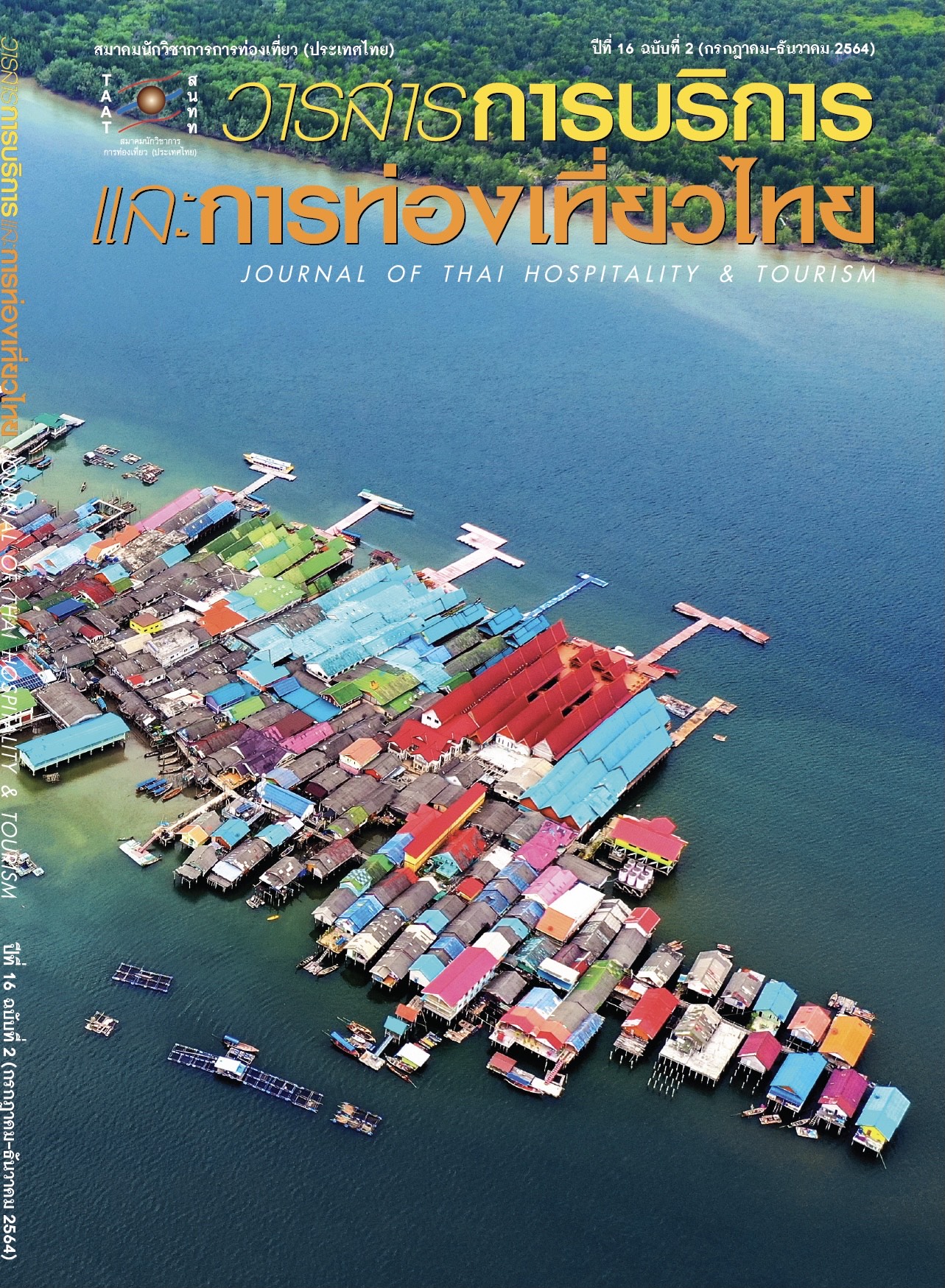Thailand Festival Tourism Promotion through Online Media
Main Article Content
Abstract
The main purposes of this research are 1) to study the influences of online media towards Thai tourists’ decision to visit the Thailand Tourism Festival, 2) to compare demographic data for the use of online media of Thai tourists on making a decision to visit the Thailand Tourism Festival, and 3) to propose guidelines for the Thailand Tourism Festival promotion through online media.
The sample population for this research was 400 Thai tourists who visited the Thailand Tourism Festival. The tool used in this research is a questionnaire. The statistics used were Nonprobability Sampling and Purposive Sampling techniques with descriptive statistics by analyzing percentage, average, frequency, and standard deviation. In order to test the hypothesis, Inferential Statistics; T-tests, and analysis of variance (One – way ANOVA/ F-test) were used.
The results of the study based on the influences of online media towards Thai tourists’ decision on visiting the Thailand Tourism Festival showed that most of the Thai tourists were single, female, age between 21 to 30 years old, with Bachelor’s degree, and their monthly income was 10,001-20,000 Baht per month, working as corporate officers. Overall, the tourists had a statistically high level of opinions regarding the influences of online media towards Thai tourists’ decision to visit the Thailand Tourism Festival. Considering each aspect, it was found that the ability of the users was at the highest level regarding data accessibility, source credibility, interactive communication, and quality of information (data) were in high, medium, and low levels, respectively. Considering statistical hypothesis testing of the respondents who decided to visit the Thailand Tourism Festival in terms of gender, age, status, level of education, and income, there was no statistically significant difference, found (of 0.05).
Article Details
References
Ampolphan, N. (2015). World Travel Trends 2015 Hipsters, Sharing, Startup. Retrieved from http://www.etatjournal.com/web/component/tags/tag/wr-nattatira
Boonlert, C. (2010). Thai Tourist’s Behavior in Using Online Room Reservation. Faculty of Business Administration, Srinakharinwirot University.
Chaichuy, P. & Satararuji, K. (2016). Thailand’s Public Issue Communication through a Communication Innovation for Campaign, Website “Change.org”. Veridian E-Journal, Silpakorn University, 9(2), 1526–1536.
Chatchakun, N. (2011). Tourism Industry. Bangkok: Chulalongkorn University Press.
Dejkamhaeng, N. & Chantuk T. (2016). Model for Quality Management of Exhibition Organization in Thailand. Veridian E-Journal, Silpakorn University, 9(2), 69–81.
Dulyasatien, W. (2016). Factors Affecting the Performance of Large Hotels Business in Thailand. Veridian E-Journal, Silpakorn University, 9(2), 2057–2070.
Electronic Transactions Development Agency. (2016). Report of Internet User Behavior Survey in Thailand 2016. Retrieved from http://www.m-society.go.th/ewt_news.php?nid=17972
Jittangwattana, B. (2014). MICE Business (Meeting Incentive Convention and Exhibition). Nonthaburi: Fernkaluang.
Kaewsuksai, R. & Jussapalo, C. (2012). Online Social Network: Facebook Usage for the Learners’ Development. Princess of Naradhiwas University Journal, 5(4), 195–205.
Kawanobe, S. (2000). The Motivations and Behaviors of Thai Tourists: A Case Study of Mueang District, Nan Province. Faculty of Business Services, Rajamangala University of Technology Thanyaburi.
Malisuwan, S. (2008). Types of Online Social Networks. Retrieved from http://smforedu.blogspot.com/2014/02/blog-post.html
Nattapongpruet, A. & Cheyjanya, P. (2016). Lifestyle, Perception Online Travel Information, Credibility, and Behavior of Decision Making for Travel Aboard. Paper Presented in the National Academic Conference 2016, National Institute of Development Administration.
Saipradit, K. (2008). Roles of Public Relation Officers in Public Relations through New Media Section 1. Journal of Technical Education Development, 20(65), 42–51.
Sangpikul, A. (2013). Research Methodology. Bangkok: Dhurakij Pundit University.
Somnuxpong, S. (2017). Trends and Tourism Marketing 4.0 in Thailand. Veridian E-Journal, Silpakorn University, 10(3), 2055–2068.
Takoolsom, P. (2016). Exhibition Organizing Strategies: the Marketing Communication Tool to Generate Experience to Customers. Journal of Communication and Management, 2(3), 62–78.
Thailand Convention and Exhibition Bureau. (2016). Annual Report 2016. Retrieved from http://www.businesseventsthailand.com/fileadmin/user_upload/documents/annual-reports/TCEB_Annual_Report_2016.pdf
Tourism Authority of Thailand. (2018). TAT Grand Opening the 38th Tourism Festival 2018. Retrieved from http://www.tatnewsthai.org/detail.php?newsID=4674
Treethong, K. (2014). Motivations in Selecting to Travel of International Tourists to Bangkok Metropolis as a Tourism Destination. Faculty of Sport Science, Chulalongkorn University.
Warakulwit, S. (2015). Tourism Industry. Bangkok: Waewwaw Printing.
Yangsabai, P. & Prachaknet, P. (2015). The Influence of Media Online Network to Intentional Surgery Concerned of Women in Bangkok. Retrieved from http://gscm.nida.ac.th/public-action/Proceeding/2558/2-2.pdf
Yoshida, D. (2015). Marketing Factors Affecting the Travel of Pha Mok Mi Wai of Thai Tourists. Paper Presented in the 5th National Conference, Panyapiwat Institute of Management.


